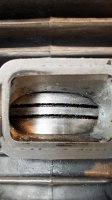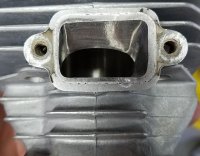- Local time
- 4:39 PM
- User ID
- 319
- Joined
- Dec 29, 2015
- Messages
- 9,614
- Reaction score
- 63,347
- Location
- Strong Island NY
@Miller Mod Saws
I personally think that the curved vs straight up and down edges have something to do with skirt wear. I try to make sure that the sides when the crown is at BDC aren't curving back in yet.
They say better than 90% of exhaust pressure, but not volume, is vented in the first 10* of crank opening. Leaving the port more elliptical than trapezoidal should create more area where you need venting but less overall area of opening the skirt needs to ride over.
I personally think that the curved vs straight up and down edges have something to do with skirt wear. I try to make sure that the sides when the crown is at BDC aren't curving back in yet.
They say better than 90% of exhaust pressure, but not volume, is vented in the first 10* of crank opening. Leaving the port more elliptical than trapezoidal should create more area where you need venting but less overall area of opening the skirt needs to ride over.









